Finally, I've managed to edit and upload the documentation of the Reframing Maidstone Event in Maidstone, back in June 2007.
Featuring John, happy participants and shot by Gareth Polmeer, archive footage copyright protected by ITN Source and Screen Archives, South East. Funded by Arts Council England, South East and Maidstone Borough Council (Art at the Centre).
Thanks to Phil Brooks, David Brooks, Hazel Addley, Bethan Cox, Louise Francis and Laura Knight of FrancisKnight and the Arts Development Team at Maidstone Borough Council.
Monday, 1 December 2008
Tuesday, 31 July 2007
Kino Derive Report




The aim of this exercise was to see how a person could discover or re-imagine a townscape by being led by archive film clips transferred to their mobile phones.
Flickering on the town hall debating chamber plasma screens the archive films appear romantic, distant, beguiling. Bulletins from another world. The challenge is to find their locations and shoot a response on the 21st century technology of the mobile phone. The graininess and jump cuts should make the formats oddly compatible.
The clips are transferred by bluetooth onto my mobile and off I go aided by a series of cryptic clues. As unfamiliar as I am with Maidstone the first isn’t much of a challenge as it clearly shows the Fremlins Brewery from 1938 and Maidstone is very proud of its new shopping precinct Fremlin Walk. Finding the location was one thing, but finding the spirit was quite a bit harder. I log a shot of the one existing part of the old brewery building – a clock arch leading to steps up to the shops. But another viewing of the clip from Sonny Hanson’s film about the Medway, ‘The Watery Trail’, clearly shows the brewery’s relationship to the river and as I wander around the shops the river is nowhere to be seen. Gavin points out that the Medway should be somewhere behind Debenhams, a brick rebuke to the river that gave birth to the town. In we go wondering whether the waterfront heritage of the site has been incorporated into the design. In the end I am forced to nudge aside re-enforced bras in the lingerie section and pull back a heavy net curtain to find a glimpse of the ‘Watery Trail’ depicted in the archive clip. I record my response as quickly as I can fearful of being nabbed as a pervert by store security.
Searching for the Fancy Dress Parade clip from 1930 I’ll confess to inside knowledge. It’s Brenchley Gardens, that much I know, and I’d wandered that way of my own accord on my first proper look round town. But how can the archive clip stimulate a renewed vision of the site. How to capture the spirit of a line-up of local craftspeople in fancy dress out for the day? After indulging in the interesting geometry of one of the fallen spires of the Houses of Parliament that found its way here following the Blitz I become aware of the teenage tribes lounging on the grass and in the bandstand. Fancy dress of a kind – the EMOs, the Goths and (I hate the word but what else do you say) the Chavs. That’s my clip – we move on quickly before they turn on us like in some B horror movie.
The shots of the bridge being built over the Maidstone Bypass in 1960 are brilliant for their capturing of the sublime beauty of iron girders. The bypass is a way up the river, but just along from Brenchley Gardens an older iron bridge provides a more than adequate response. It takes several clips to do justice to its form and relationship to the river running below but after a train trundles past into Maidstone East I feel I’ve found my Medway bridge.
I now have to climb a steep hill heading away from the town to find the vantage point depicted in the archive clip showing a fleet of buses on their way to Madrid. The titles on the original 1922 film, ‘From Maidstone to Madrid’ read, “ Spanish Authorities order – in face of keen world competition – a fleet of British built Buses, for first Bus Service in the Capital”. I’m some way up before I get to the vantage point from where my 10-second clip was shot 85 years ago, but find what I think is the exact spot. In an odd reversal there appear to be more trees now than in 1922, only one building from the original view remains.
With my circuit complete I slope back into town collecting a waterside shot of my own on the way. I send one clip to the hub by MMS which greets my on the Maidstone Video Map as I enter the Council Chambers before ‘toothing’ my remaining video-phone topographical film to a laptop for upload into the map.
Self-authorship of the landscape: from the Phantom Ride to the Mobile Phone
“The modern avenue served as laboratory for the flâneur, while the contemporary street finds the neo- flâneur manipulating the mediating filters of technology in pursuit of new connections to the landscape.” Glenn Bach. Atlas Peripatetic (MFA Project Report).
<1> Film-maker Patrick Keiller has identified that a common feature of the early city films of late 19th and early 20th Century was that they tended to be “one to three minutes long, and consisted of one or very few unedited takes”. This format is again becoming popular with the using of online video-sharing, and self-broadcasting websites such as YouTube and Google Video. The development of portable devices such as mobile phones presents new opportunities for topographical film-makers as short clips can be shot on the move and sent directly from the location to a website, or another device, where they can be simultaneously viewed and commented upon.
<2> This also has implications for the time-space compression (David Harvey) as people can broadcast to a potentially large audience images of the landscape as they pass through it in real-time and experience moving image bulletins from the past in-situ. Like the early city films these clips or bulletins will necessarily be short and unedited.
<3> Our visions of the landscape can now be filtered through a digital interface. Collectively these visions form a snapshot of the townscape and the personal topographies of the auteurs. The exchange that takes place on a kino dérive between author and instigator/ provocateur transforms the personal into the shared experience of space and place, spanning past and present.
A video map is created, logging the journeys undertaken. This then enables us to explore the changes and tensions, highlight historic symmetries and developments.
<4> By viewing archive film images in situ what historical tensions emerge? When standing in Fremlin Walk looking at Sonny Hanson’s film showing Fremlins Brewery in 1938 it’s difficult not to become aware of the economic and cultural transformation that has occurred as we have moved from distinctive local industries to a homogenised shopping mall culture.
<5> Can this simple act of authoring our own representation of our environment somehow give us a link to collective sense of place beyond that defined by urban planning, the privatisation of public space and received notions of localness and belonging? Somehow enable access to what Nick Papadimitriou calls a kind of “regional memory” locked in the landscape. A route to a sense and spirit of place which is inclusive.
<6> With the traditional psychogeographical dérive or drift we seek to strip the city or town bare, to reveal its secrets, its mechanisms and motors. The motivations for engaging in such an activity vary as much as the outcomes. For the Situationists it was a reconnaisance mission for the revolution of everyday life that they sought to bring about. The fact that they moved on from drinking absinthe in Montmatre to being at the heart of the revolt of May ’68 that brought the French government to the brink of collapse suggests some use came from these “journeys outside the timetable.”
<7> With a kino dérive we don’t anticipate a revolution in the traditional sense to occur, although it would be nice. It is an experiencing of place through a simultaneous active engagement with moving image and the landscape.
<1> Film-maker Patrick Keiller has identified that a common feature of the early city films of late 19th and early 20th Century was that they tended to be “one to three minutes long, and consisted of one or very few unedited takes”. This format is again becoming popular with the using of online video-sharing, and self-broadcasting websites such as YouTube and Google Video. The development of portable devices such as mobile phones presents new opportunities for topographical film-makers as short clips can be shot on the move and sent directly from the location to a website, or another device, where they can be simultaneously viewed and commented upon.
<2> This also has implications for the time-space compression (David Harvey) as people can broadcast to a potentially large audience images of the landscape as they pass through it in real-time and experience moving image bulletins from the past in-situ. Like the early city films these clips or bulletins will necessarily be short and unedited.
<3> Our visions of the landscape can now be filtered through a digital interface. Collectively these visions form a snapshot of the townscape and the personal topographies of the auteurs. The exchange that takes place on a kino dérive between author and instigator/ provocateur transforms the personal into the shared experience of space and place, spanning past and present.
A video map is created, logging the journeys undertaken. This then enables us to explore the changes and tensions, highlight historic symmetries and developments.
<4> By viewing archive film images in situ what historical tensions emerge? When standing in Fremlin Walk looking at Sonny Hanson’s film showing Fremlins Brewery in 1938 it’s difficult not to become aware of the economic and cultural transformation that has occurred as we have moved from distinctive local industries to a homogenised shopping mall culture.
<5> Can this simple act of authoring our own representation of our environment somehow give us a link to collective sense of place beyond that defined by urban planning, the privatisation of public space and received notions of localness and belonging? Somehow enable access to what Nick Papadimitriou calls a kind of “regional memory” locked in the landscape. A route to a sense and spirit of place which is inclusive.
<6> With the traditional psychogeographical dérive or drift we seek to strip the city or town bare, to reveal its secrets, its mechanisms and motors. The motivations for engaging in such an activity vary as much as the outcomes. For the Situationists it was a reconnaisance mission for the revolution of everyday life that they sought to bring about. The fact that they moved on from drinking absinthe in Montmatre to being at the heart of the revolt of May ’68 that brought the French government to the brink of collapse suggests some use came from these “journeys outside the timetable.”
<7> With a kino dérive we don’t anticipate a revolution in the traditional sense to occur, although it would be nice. It is an experiencing of place through a simultaneous active engagement with moving image and the landscape.
Saturday, 16 June 2007
Today's the day

Come down to the Town Hall today and join us. Download some archive clips to your phone, go and hunt for the locations around the town (or find something similar). Then come back and we'll load your clips into our video map.
If you can't come along today or next Saturday 23rd, you can still participate by sending us a clip of wherever you are and we'll send you an archive clip of Maidstone in return.
Send your clips by MMS to 07828 611700
email: reframem@googlemail.com
Friday, 1 June 2007
A Lunchtime Derive- Part 2
“ Let yourself be drawn to places, look up, down and note any encounters you make along the way be they architectural, human, flora or fauna. Pick up found objects. Take every interaction as an opportunity to feed into the record of your journey”.
A ‘lunchtime derive’. Maidstone. 11th May 2007. 12.30pm. Meeting Point: outside the Tourist Information office.
Walking to meet, Laura, Lou, Nina and Bill I had a sense of a coming together, a gathering. Four people arriving from different places around the town to walk and share their experience of Maidstone. This feeling was probably made more acute as I was travelling amongst a throng of shoppers, like a salmon swimming against the current.
Notepads handed out, cameras and camera phones. Instructions read and digested.
Below you will find the algorithm for your Dérive:
2nd Right
2nd Right
1st Left
Repeat
Start from any point near the centre of town, ie. Outside the tourist information office and follow the algorithm above. Try to find a spot you are drawn to, make a note of it, and the reason you were drawn to that spot. If you come to a dead end return to a point where you can resume with the formula. Allow yourself to be drawn in new and interesting directions.
Make a note of the route you take and the various atmospheres and ambiences you experience. You may find that what constitutes the ‘2nd Right’ or 1st Left is sometimes open to interpretation. Make a note of these moments of indecision and the reason you choose the turning you do.
Have fun, the derive is a playful-constructive activity.
“Psychogeography was merely a preparation, a reconnaissance for the day when the city would be seized for real.” Simon Sadler, The Situationist City
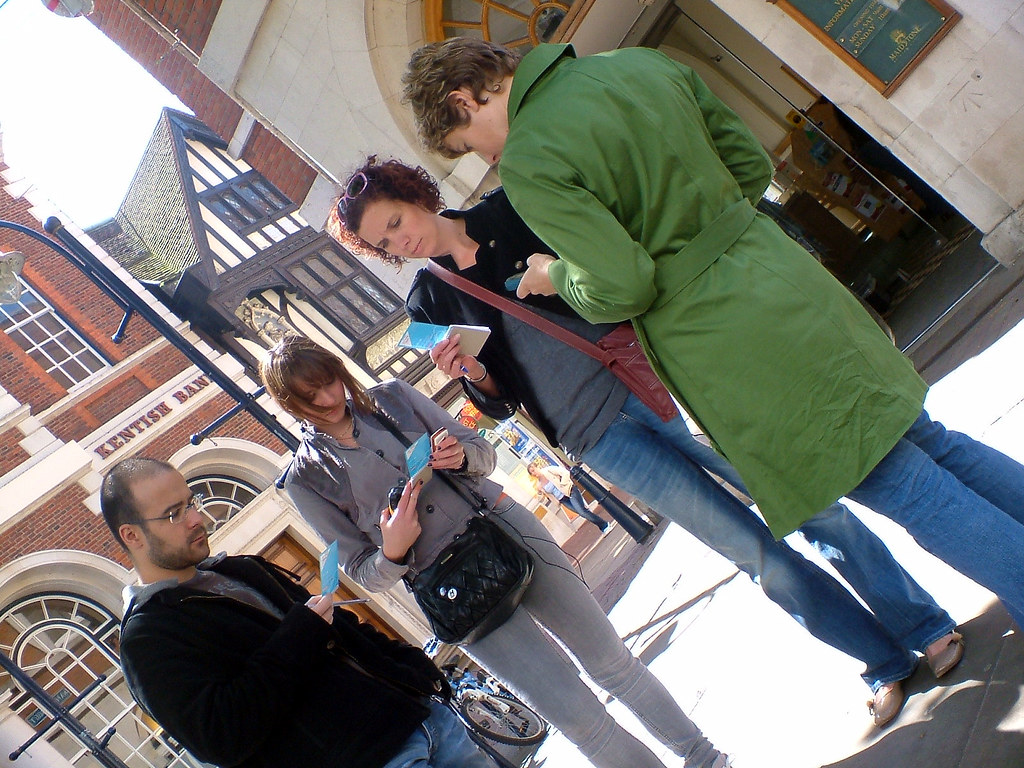
Louise goes south, Nina east, Bill north and Laura west. My aim is to follow one and come across all at some point but this proves difficult and I end up drifting off my course. I become aware of being part of an act, a survey being carried out and something unknown being collected.
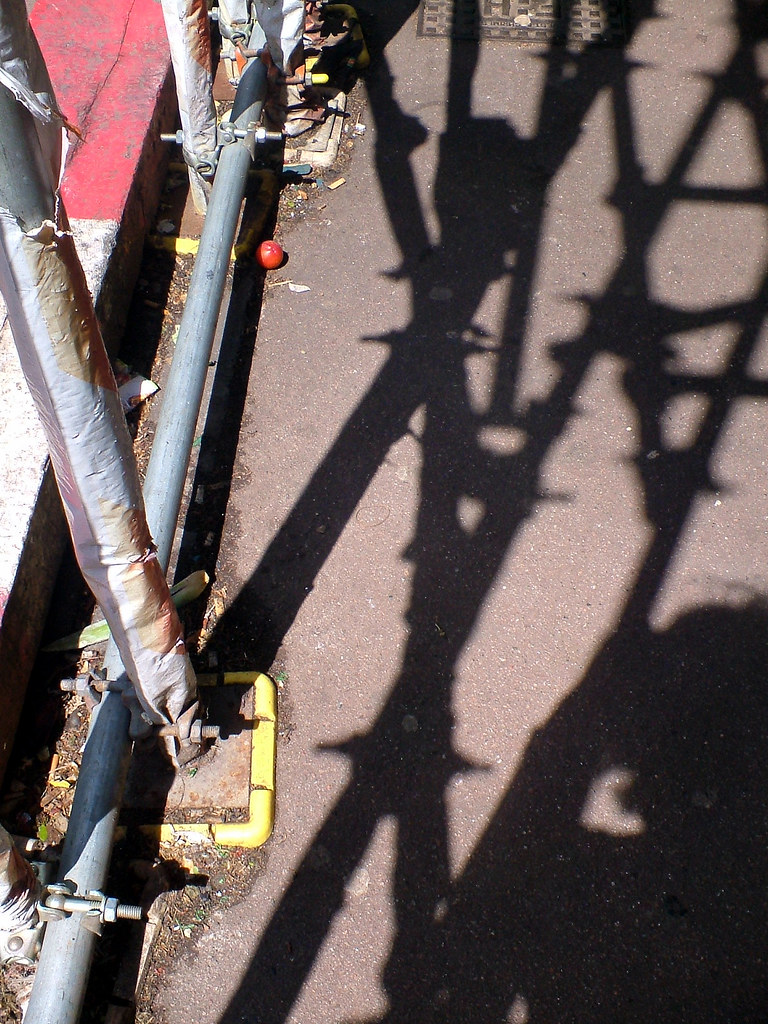
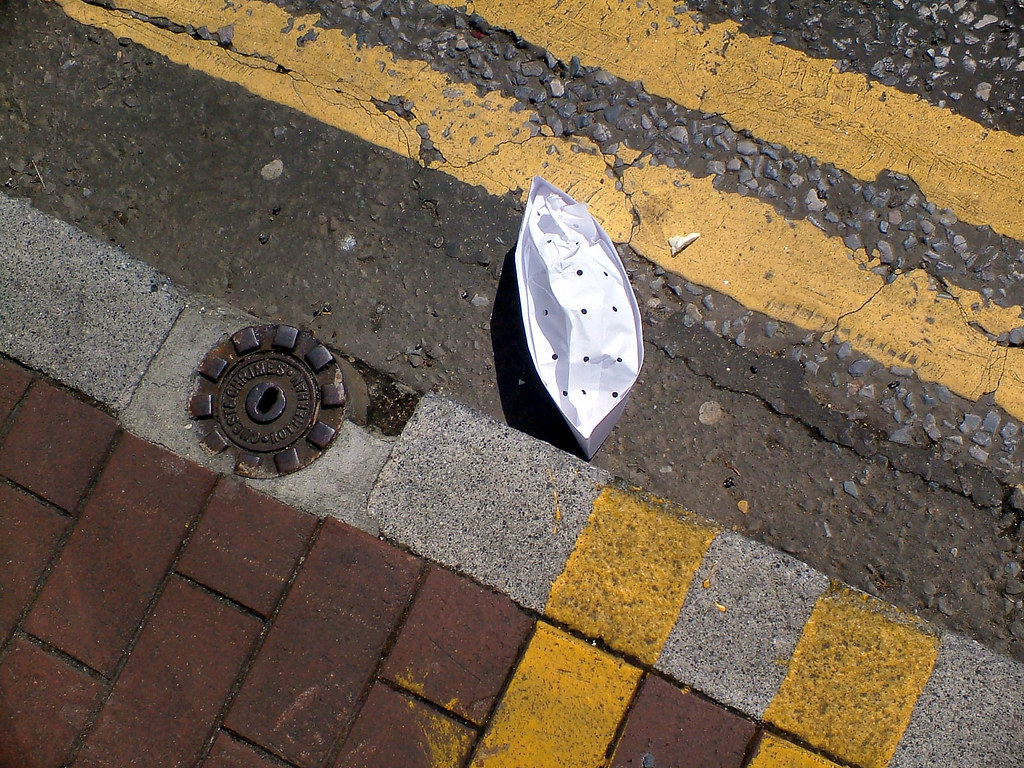

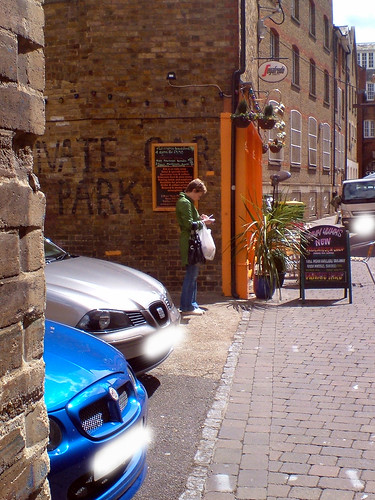
Forty minutes later we meet back where we started. One at a time they arrive at the start. Nina first.
First year video student from UCCA. Nina’s from Oslo and used to an urban town. She finds Maidstone small and has only been here since September. She regularly comes into town but follows a similar route each time. Over the bridge from Lockmeadow, up the High Street, into Fremlin Walk or through Market Buildings. Or up the high street and through the chequers centre to Sainsbury’s and then home. Back the same way. She started her derive in the opposite direction to where she normally walks. This is her account.
“Down Bank street with small shops and bars. Near Chicago Rock Café. Road work. Lots of construction noises (managed to loose derive instructions on the way). Turned 2nd right near Barclays Bank. Road on left hand. Turned 2nd right again after Drakes pub, up Medway street. Feels like a back alley without anything special. Old House at Home is in front of me. The whole building looks amazing so old, so cosy and next to it is the Tea Room with the same style. Turn 1st left onto Pudding Lane “Gates” to Fremlin Walk in front of me. Then I turn 1st left again just by a photography store (which sells lots of old, and new cameras and equipment). I come to a parking lot to “the courtyard”, which apparently is a service which helps out people with disabilities and psychological issues. But the whole building is just amazing. In front it looks really clean and “summery” with palm trees but on the side it looks old and very special with art."


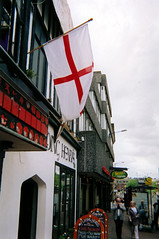
Bill arrives a couple of minutes later. Bill’s from Greece and is a 2nd year video student at UCCA.
“High Street: Beautiful, sunny day, Gabriels Hill full of people. Small path next to the hills entrance seems “neglected”, “unnoticed”. Interesting angles. Stairs. Dead End: A closed door leading to the Chequers Shopping Centre. Full of graffiti. I decide to take the first right instead of the second. Path leading to a lower level, behind the buildings. First left: Another dead end: A door leading to the inside of The Mall.
I decide to take the first right and follow my algorithm from the beginning.
Mysterious small street at the back of High Street’s building. Tranquillity. A man smoking/taking a break. The street leads straight to Grabriels Hill right in front of a Kebab Restaurant. It is a rather “voyeuristic” view.
Deadend!
I decide to move down Gabriel’s Hill, restarting the algorithm. Second right: At Maidstone’s main street, parallel to High Street. Second Right: Another small, tranquil street."

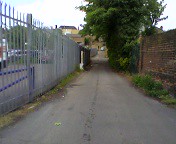


Bill really enjoyed the derive. He was amazed by the amount of alleyways and once taken the amazing quiet, leaving the buzz of street life behind.”
Laura and Louise have lived in Maidstone most of their lives.
Louise comes back first and is surprised that even though she knows the town well the experience threw up some interesting surprises. The fact that the algorithm kept taking her back to Fremlin Walk, even though she desperately wanted to go somewhere else. Even though she didn’t want to linger in Market Buildings as she felt she knew it well there were still things to draw her attention.
“High Street, Pudding Lane, buses, pollution, traffic.
Pudding Lane, lots of warning signs. Quaint T-shop.
Fremlin Walk – House of Fraser. Dead end. Corporate, clean. Plastic plants, brick walls shopping, lots of shopping. Souless.
Fremlin Walk. Drawn to open circular space. View of museum, people sitting/chatting. Framed architecture.
Back to route – officials – suits – purple/grey/beige
Back to Fremlin – don’t want to go back – turn back on steps towards Pudding Lane.
Medway street – rooftops and car parks.
Avis car hire – beautiful buildings, gated swamped by Fremlin Walk.
Fairmeadow – over lights to river – walk blocked by barrier. River to my right narrowing path – decide to take it – bit scared. Risked life crossing the road to aspects – new development oasis of tranquillity beside a dual carriageway!”
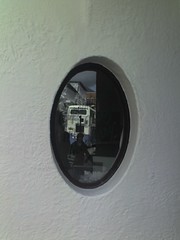
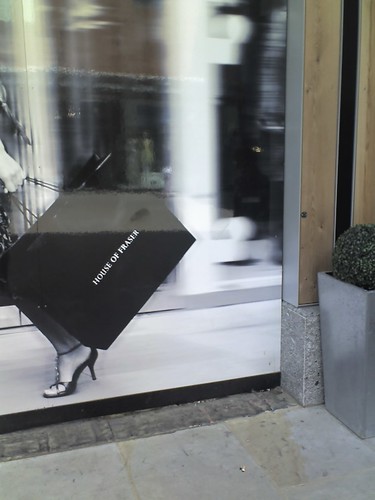
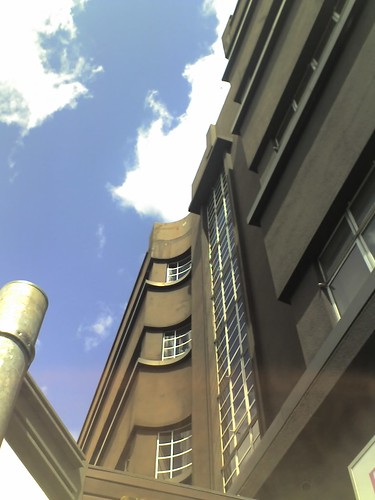
Laura followed.
"Windy street, bright sunlight.
1st picture – deadend 1st left gated entrance ended up in public toilets! Bizarre sign – “please don’t take the toilet seats”.
Deadend – alleyway took me into back of Yumm Yumm’s! Secret passageway – smelly drains! Looks from people, started filming. Drawn to one yellow brick painted on side of building. Started again at end of Rose Yard/Earl Street area. Through busy town up side road – quiet courtyard back of buildings – tree lined (James Court).
Turned up Union street, deadend. Church entrance. Drawn to ophthalmic. Sad building, lots of memories as a child."
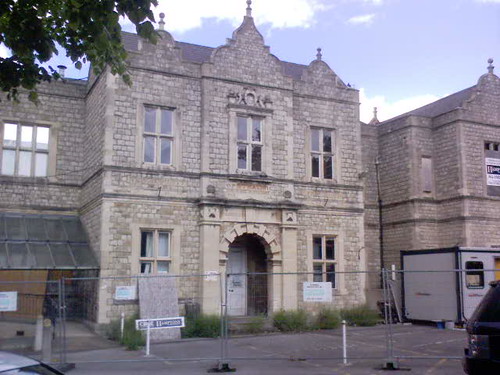
We exchanged photos and videos, ate a sandwich and each departed in separate directions.
On the way home I found this sitting on a wall outside Kent CC offices.
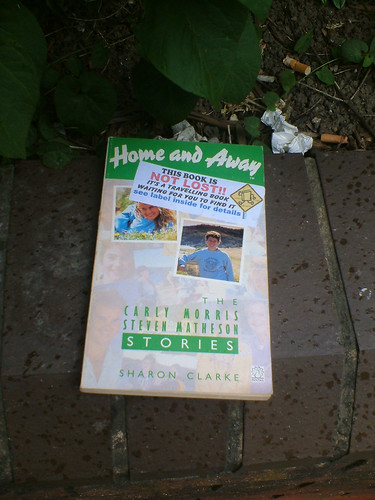
A ‘lunchtime derive’. Maidstone. 11th May 2007. 12.30pm. Meeting Point: outside the Tourist Information office.
Walking to meet, Laura, Lou, Nina and Bill I had a sense of a coming together, a gathering. Four people arriving from different places around the town to walk and share their experience of Maidstone. This feeling was probably made more acute as I was travelling amongst a throng of shoppers, like a salmon swimming against the current.
Notepads handed out, cameras and camera phones. Instructions read and digested.
Below you will find the algorithm for your Dérive:
2nd Right
2nd Right
1st Left
Repeat
Start from any point near the centre of town, ie. Outside the tourist information office and follow the algorithm above. Try to find a spot you are drawn to, make a note of it, and the reason you were drawn to that spot. If you come to a dead end return to a point where you can resume with the formula. Allow yourself to be drawn in new and interesting directions.
Make a note of the route you take and the various atmospheres and ambiences you experience. You may find that what constitutes the ‘2nd Right’ or 1st Left is sometimes open to interpretation. Make a note of these moments of indecision and the reason you choose the turning you do.
Have fun, the derive is a playful-constructive activity.
“Psychogeography was merely a preparation, a reconnaissance for the day when the city would be seized for real.” Simon Sadler, The Situationist City

Louise goes south, Nina east, Bill north and Laura west. My aim is to follow one and come across all at some point but this proves difficult and I end up drifting off my course. I become aware of being part of an act, a survey being carried out and something unknown being collected.




Forty minutes later we meet back where we started. One at a time they arrive at the start. Nina first.
First year video student from UCCA. Nina’s from Oslo and used to an urban town. She finds Maidstone small and has only been here since September. She regularly comes into town but follows a similar route each time. Over the bridge from Lockmeadow, up the High Street, into Fremlin Walk or through Market Buildings. Or up the high street and through the chequers centre to Sainsbury’s and then home. Back the same way. She started her derive in the opposite direction to where she normally walks. This is her account.
“Down Bank street with small shops and bars. Near Chicago Rock Café. Road work. Lots of construction noises (managed to loose derive instructions on the way). Turned 2nd right near Barclays Bank. Road on left hand. Turned 2nd right again after Drakes pub, up Medway street. Feels like a back alley without anything special. Old House at Home is in front of me. The whole building looks amazing so old, so cosy and next to it is the Tea Room with the same style. Turn 1st left onto Pudding Lane “Gates” to Fremlin Walk in front of me. Then I turn 1st left again just by a photography store (which sells lots of old, and new cameras and equipment). I come to a parking lot to “the courtyard”, which apparently is a service which helps out people with disabilities and psychological issues. But the whole building is just amazing. In front it looks really clean and “summery” with palm trees but on the side it looks old and very special with art."



Bill arrives a couple of minutes later. Bill’s from Greece and is a 2nd year video student at UCCA.
“High Street: Beautiful, sunny day, Gabriels Hill full of people. Small path next to the hills entrance seems “neglected”, “unnoticed”. Interesting angles. Stairs. Dead End: A closed door leading to the Chequers Shopping Centre. Full of graffiti. I decide to take the first right instead of the second. Path leading to a lower level, behind the buildings. First left: Another dead end: A door leading to the inside of The Mall.
I decide to take the first right and follow my algorithm from the beginning.
Mysterious small street at the back of High Street’s building. Tranquillity. A man smoking/taking a break. The street leads straight to Grabriels Hill right in front of a Kebab Restaurant. It is a rather “voyeuristic” view.
Deadend!
I decide to move down Gabriel’s Hill, restarting the algorithm. Second right: At Maidstone’s main street, parallel to High Street. Second Right: Another small, tranquil street."




Bill really enjoyed the derive. He was amazed by the amount of alleyways and once taken the amazing quiet, leaving the buzz of street life behind.”
Laura and Louise have lived in Maidstone most of their lives.
Louise comes back first and is surprised that even though she knows the town well the experience threw up some interesting surprises. The fact that the algorithm kept taking her back to Fremlin Walk, even though she desperately wanted to go somewhere else. Even though she didn’t want to linger in Market Buildings as she felt she knew it well there were still things to draw her attention.
“High Street, Pudding Lane, buses, pollution, traffic.
Pudding Lane, lots of warning signs. Quaint T-shop.
Fremlin Walk – House of Fraser. Dead end. Corporate, clean. Plastic plants, brick walls shopping, lots of shopping. Souless.
Fremlin Walk. Drawn to open circular space. View of museum, people sitting/chatting. Framed architecture.
Back to route – officials – suits – purple/grey/beige
Back to Fremlin – don’t want to go back – turn back on steps towards Pudding Lane.
Medway street – rooftops and car parks.
Avis car hire – beautiful buildings, gated swamped by Fremlin Walk.
Fairmeadow – over lights to river – walk blocked by barrier. River to my right narrowing path – decide to take it – bit scared. Risked life crossing the road to aspects – new development oasis of tranquillity beside a dual carriageway!”



Laura followed.
"Windy street, bright sunlight.
1st picture – deadend 1st left gated entrance ended up in public toilets! Bizarre sign – “please don’t take the toilet seats”.
Deadend – alleyway took me into back of Yumm Yumm’s! Secret passageway – smelly drains! Looks from people, started filming. Drawn to one yellow brick painted on side of building. Started again at end of Rose Yard/Earl Street area. Through busy town up side road – quiet courtyard back of buildings – tree lined (James Court).
Turned up Union street, deadend. Church entrance. Drawn to ophthalmic. Sad building, lots of memories as a child."

We exchanged photos and videos, ate a sandwich and each departed in separate directions.
On the way home I found this sitting on a wall outside Kent CC offices.

The Moon Over Maidstone
I was wandering back from the Druids after a meeting with AQQ editor Mark Hewitt and Mark Barnes, the 'worlds fourth greatest illustrator' his words, not mine - it was just getting dark and it occured to me that even in the most edgiest of places the romantic qualities of place can be found (or is that more like, after a couple of small sherrys the most romantic side of me emerges!) Perceptions of place - a constant quest.
This was my thought... kindly reworded by John...
"There was a crescent moon shining above the Methodist Church in Week Street. Opposite glowed the golden arches of new god of Mc Donald’s. Young lovers sat and super-sized themselves in their temple of fast food where once they swooned beneath the moon."
This was my thought... kindly reworded by John...
"There was a crescent moon shining above the Methodist Church in Week Street. Opposite glowed the golden arches of new god of Mc Donald’s. Young lovers sat and super-sized themselves in their temple of fast food where once they swooned beneath the moon."
Sunday, 15 April 2007
The Maiden Stone and the Earth Grid

Maidtsone is a place of great antiquity. One reading of the name is that it is derived from ‘The Stone of the Maidens’. E.O. Gordon writes that "Maiden" is a corruption of the Sanskrit and Arabic term Maidan meaning "an open place of public meeting". The stone being the signifier of this place of gathering, possibly part of a large stone circle such as the Merry Maidens in Cornwall.

As such a place of antiquity it sits upon large concentrations of earth energy with a ley line running through the town. Some marginal Christian cults believe Maidstone to be part of the Earth Grid and “the bizarre lattice patterns of Satan. “ One such cult recently travelled through Kent tracing “the effects that prayer warfare has had on this area. “

“As we come through Maidstone we note that there is
quite a bit of activity through Maidstone. There is a
church to the south that is connected. You will notice
that there are many places of antiquity along these
lines too and different places like crossroads that
hold quite a activity of Satanic influences. You can
see too as we travel across a place called Godstone
the `stones' are quite relevant to the situation too.
One with `god' on it, obviously. “
Subscribe to:
Posts (Atom)